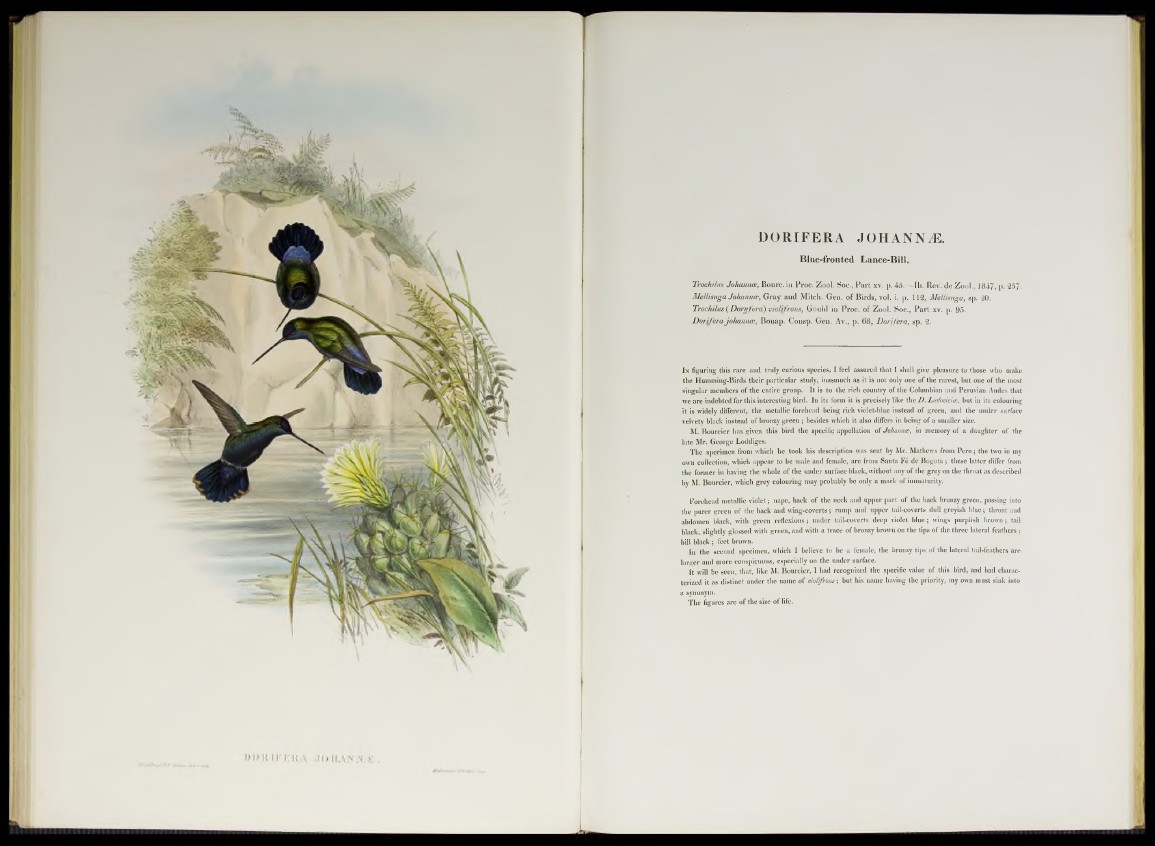
DORIFERA JOHANNiE.
Rlue-fronted Lance-Bill.
Trockilus Johannce, JBourc. in Proc. Zool. Soc., Part xv. p. 45.—Ib. Rev. de Zool., 1847, p. 257.
Mellisuga Johannce, Gray and Mitch. Gen. of Birds, vol. i. p. 112; Mellisuga, sp. 20.
Trockilus (Doryferd) violifrons, Gould in Proc. of Zool. Soc., Part xv. p. 95.
Dorif'era johannce, Bonap. Consp. Gen. Av., p. 68, Dorifera, sp. 2.
I n figuring this rare and truly curious species, I feel assured that I shall give pleasure to those who make
the Humming-Birds their particular study, inasmuch as it is not only one of the rarest, but one of the most
singular members of the entire group. It is to the rich country of the Columbian and Peruvian Andes that
we are indebted for this interesting bird. In its form it is precisely like the D. Ludovicias, but in its colouring
it is widely different, the metallic forehead being rich violet-blue instead of green, and the under surface
velvety black instead of bronzy green ; besides which it also differs in being of a smaller size.
M. Bourcier has given this bird the specific appellation of Johannce, in memory of a daughter of the
late Mr. George Loddiges.
The specimen from which he took his description was sent by Mr. Mathews from Peru; the two in my
own collection, which appear to be male and female, are from Santa Fé de Bogota; these latter differ from
the former in having the whole of the under surface black, without any of the grey on the throat as described
by M. Bourcier, which grey colouring may probably be only a mark of immaturity.
Forehead metallic violet; nape, back of the neck and upper part of the back bronzy green, passing into
the purer green of the back and wing-coverts; rump and upper tail-coverts dull greyish blue; throat and
abdomen black, with green reflexions; under tail-coverts deep violet blue; wings purplish brown ; tail
black, slightly glossed with green, and with a tracé of bronzy brown on the tips of the three lateral feathers ;
bil! black; feet brown.
In the second specimen, which I believe to be a female, the bronzy tips of the lateral tail-feathers are
larger and more conspicuous, especially on the under surface.
It will be seen, that, like M. Bourcier, I had recognized the specific value of this bird, and had charac-
terized it as distinct under the name of violifrons; but his name having the priority, my own must sink into
a synonym.
The figures are of the size of life.